Interior/Exterior Form and Property Research on Wu-Style Residential Houses from the Perspective of Sustainable Development
Abstract
1. Introduction
2. Literature Review
2.1. Internal and External Spaces of Architecture
2.2. Architectural Regionality
2.3. Traditional Dwellings
2.4. Review
3. Research Subjects
4. Definition
4.1. Definition of Interior/Exterior Form
4.2. Definition of Interior/Exterior Properties
5. Methods
5.1. Extracting the Interior/Exterior Form
5.2. Extracting the Interior/Exterior Properties
6. Classification Analysis of the Interior/Exterior Form and Properties of Wu-Style Architecture
6.1. Classification and Analysis of the Interior/Exterior Form
6.2. Classification and Analysis of Interior/Exterior Properties
7. Characteristic Analysis of the Interior/Exterior of Wu-Style Architecture
7.1. Interior/Exterior Type Analysis
7.2. The Relationship between the Interior/Exterior Type and the Regional Environment
7.2.1. Adaptability to Cultural Environment
7.2.2. Environmental Adaptability
8. Conclusions
Author Contributions
Funding
Institutional Review Board Statement
Informed Consent Statement
Data Availability Statement
Conflicts of Interest
References
- Shimizu, H. Exterior Space of the Building; Zhang, L.L., Ed.; China Architecture and Building Press: Beijing, China, 2002. [Google Scholar]
- Beichuan, K.; Nishiyama, N. Floor Plan Characteristic of Modern Houses by Focusing on Room Floor Area and Wall Length. Rep. Archit. Inst. Jpn. 2007, 4, 129–136. [Google Scholar]
- Kitagawa, K.; Yamada, Y.; Usui, M.; Nishiyama, N. Floor Plan Characteristic of Modern Houses in Consideration of Outline, Zone and Path, spatial composition and flow lines. Rep. Archit. Inst. Jpn. 2008, 7, 1469–1476. [Google Scholar]
- Kitagawa, K.; Kamata, H. The Inner and Outer Boundaries of Japanese Houses in Consideration of Form and Nature. Rep. Archit. Inst. Jpn. 2009, 12, 2595–2604. [Google Scholar]
- Kamata, Y.; Yuji, I.T.O.; Kitagawa, K. Boundary of modern housing works considering form and nature. Rep. Archit. Inst. Jpn. 2010, 1, 2343–2352. [Google Scholar]
- Hiromi, I.; Keisuke, K. The Inner and Outer Boundary of the Main Room of a Modern Residential Work Considering Its Form and Nature. Tokai Branch Res. Rep. 2013, 2, 473–476. [Google Scholar]
- Ashihara, Y. External Space Composition: From Architecture to City; Shokoku-Sha Shrine: Tokyo, Japan, 1962; Volume 4. [Google Scholar]
- Alexander, C. Notes on the Synthesis of Form; Harvard University Press: Cambridge, MA, USA, 1964. [Google Scholar]
- Alexander, C. A Pattern Language: Towns, Building and Construction; Oxford University Press: London, UK, 1977. [Google Scholar]
- Kurokawa, K.; Liang, H. Japanese Gray Tone Culture. World Archit. 1981, 7, 57–61. [Google Scholar]
- Yahagi, K. Spatial Architecture; Ex-Knowledge Corporation: Tokyo, Japan, 2004; Chapter 3. [Google Scholar]
- Hirata, K.; Moriyasu, H. Analysis on the Spatial Morphology of Spatial Domain Divisions Research on the Space and Consciousness Areas Inside and Outside Houses Centering on Openings Part 1. J. Archit. Build. Sci. 1998, 63, 75–82. [Google Scholar]
- Hirata, K.; Moriyasu, H.; Hirokuni, T. An Analysis of the Formation and Means on Sphere of Space Based one the Combination of Each Sphere of Space around Openings: A study on the sphere of space and consciousness to interior and exterior space around openings in housing Part 2. Rep. Archit. Inst. Jpn. 1999, 3, 107–114. [Google Scholar]
- Hirata, K.; Moriyasu, H.; Taniguchi, H. The relationship between the spatial domain and the formation of consciousness domain from the perspective of the lifestyle assumed by the residents’ research on the space inside and outside of the house and the consciousness domain centering on the opening part 3. Rep. Archit. Inst. Jpn. 2001, 66, 109–116. [Google Scholar]
- Mustafa, F.A.; Hassan, A.S. Spatial-Functional Analysis of Kurdish Courtyard Houses in Erbil City. Am. J. Eng. Appl. Sci. 2010, 3, 560–568. [Google Scholar] [CrossRef][Green Version]
- Yusuke, I.; Masato, M. A Study on Special Formation of Hunan Province Rural House in Hunan Province China. Tokai Branch Res. Rep. 2012, 50, 749–752. [Google Scholar]
- Ushiyama, Y.; Takada, N. A Study on the Vague Boundaries around the Openings of Contemporary Houses in City. Archit. Plan. 2013, 8, 649–650. [Google Scholar]
- Park, S. Characteristics of Interior Space in Huizhou Traditional Houses. J. Korean Hous. Assoc. 2015, 26, 147–155. [Google Scholar] [CrossRef]
- Liu, S.S.; Cheng, Y.Y. Spatial Morphological Characteristics of Traditional Residential Courtyards in Eastern Henan. Urban Archit. 2020, 17, 59–61. [Google Scholar]
- Zhang, Y.C.; Chen, Y.; Wang, X.J. Research on the Typological Characteristics of Xi′an Residential Buildings in the Context of History and Culture. Archit. J. 2016, S1, 135–141. [Google Scholar]
- Xiao, Z.G. Application of Gray Space in Modern Public Buildings; Hunan Normal University: Changsha, China, 2009. [Google Scholar]
- Du, J.; Guan, X.S. Analysis of the Use of Gray Space in Residential Space Design. Furnit. Inter. Decor. 2019, 1, 116–117. [Google Scholar]
- Guo, J. Research on the Spatial Composition of Qingdao Liyuan; Beijing University of Civil Engineering and Architecture: Beijing, China, 2014. [Google Scholar]
- Li, W. Shaping Pleasant Interior Space: Reflections on the Realization of Modern Green Office Building Space Design. Sino-Foreign Archit. 2011, 6, 122–124. [Google Scholar]
- Li, W.X. Analysis of Influencing Factors of High-rise Residential Graphic Design in Southern China. Sci. Technol. Inf. 2009, 13, 647–648. [Google Scholar]
- Yang, Y.Y. Research on Gray Space of Traditional Architecture in Wuzhou. Guangxi Academy of Arts of Guangxi Artists Association. In Proceedings of the China-ASEAN Architectural Space Design Education Summit Forum, Seoul, Kroea, 24 April 2015; pp. 154–156. [Google Scholar]
- Zhang, J.; Jin, Y. Research on the External Space of Waterfront Architecture in Wuzhen Ancient Town. Cent. China Archit. 2008, 8, 192–196. [Google Scholar]
- Frampton, K. Modern Architecture—A Critical History; Zhang, Q.N., Ed.; China Architecture & Building Press: Beijing, China, 1998. [Google Scholar]
- Poulsen, M.; Lauring, M. The Historical Influence of Landscape, Ecology and Climate on Danish Low-rise Residential Architecture. Int. J. Des. Nat. Ecodynamics 2019, 14, 91–102. [Google Scholar] [CrossRef]
- Tang, S.Y.; Lee, Y.S. Comparisons and Analysis on Architectural Features of Seven Typical Traditional Dwellings in China. KIEAE J. 2014, 14, 5–13. [Google Scholar] [CrossRef]
- Lawrence, R.J. The Interpretation of vernacular architecture. Vernac. Archit. 1983, 14, 19–28. [Google Scholar] [CrossRef]
- Le, D.V. Vietnamese Folk Architecture: Regional Architecture Based on Climatic Adaptation. Des. J. 2018, 21, 855–862. [Google Scholar] [CrossRef]
- Jeon, B.H. A Preliminary Study on the Local Traditions and Its Transition of Architectural Relics in the Northern Region in Korea. J. Archit. Inst. Korea Plan. Des. 2005, 21, 107–118. [Google Scholar]
- Pilyak, S.A. Research in Regional Features of Wooden Cult Architecture of the Kostroma Province. Ind. Civ. Eng. 2015, 12, 45–49. [Google Scholar]
- Zhang, X.G.; Feng, D. The Regionality of Southwest Regional Culture and Architectural Creation. Times Archit. 2006, 4, 38–41. [Google Scholar]
- Xu, H. A Preliminary Study on the Development and Evolution of Traditional Residential Courtyard Space in Bashu. Archit. Tech. 2014, 3, 104–106. [Google Scholar]
- Wu, R.; Zhu, M.Y. Exploration on the Regional Expression of Building Materials. Archit. Cult. 2020, 3, 241–243. [Google Scholar]
- Ge, S.Z. Regional Expression of Huizhou Cultural Architecture based on the Perspective of Materials: A Case Study of Jixi Museum. Urban Archit. 2021, 18, 73–75. [Google Scholar]
- Gan, X.Y.; Fan, C.; Hu, A. Analysis of Regional Characteristics of Tibetan Residential Facades Based on Fractal Theory. Cent. China Archit. 2018, 36, 107–110. [Google Scholar]
- Ha, J.; Pan, R. Analysis on the Regional Characteristics of Traditional Houses of “Zhuang Jiao” in Qinghai. Cent. China Archit. 2009, 27, 89–91. [Google Scholar]
- Li, F.; Hu, X.Y.; Wu, N.; Wen, T.R. Study on the Regional Features of Traditional Village Residential Architecture in Quzhou. Archit. Cult. 2018, 9, 222–223. [Google Scholar]
- Sun, R.Y.; Guo, J.Y. Study on the Regional Expression of Traditional Houses of the Li People in Hainan. Cent. China Archit. 2015, 33, 138–140. [Google Scholar]
- Yang, T.; Mu, J.J. The Influence of Regional Climate on the Architectural Form of Residential Buildings in Kashgar, Xinjiang. Shanxi Archit. 2009, 35, 43–44. [Google Scholar]
- Zhang, Y.T. A Preliminary Study on the Characteristics of Regional Residential Buildings in Northern Henan. Small Town Constr. 2013, 6, 94–97. [Google Scholar]
- Lu, Y. Fifty years of research on Chinese folk houses. J. Archit. 2007, 11, 66–69. [Google Scholar]
- Long, F.L. Cave Complex Test. Chin. Soc. Build. Sci. 1934, 5, 55–76. [Google Scholar]
- Liu, Z.P. A Seal in Yunnan. Chin. Soc. Build. Sci. 1944, 7, 63–94. [Google Scholar]
- Liu, D.Z. Introduction to Chinese Housing; Architectural Engineering Press: Beijing, China, 1957. [Google Scholar]
- Li, X.F. Vernacular Architecture: Interdisciplinary Research Theory and Methods; China Architecture and Building Press: Beijing, China, 2005. [Google Scholar]
- Cao, M.R. Economical and Practical Introduction to the Traditional Dwellings of Miao People in Western Hunan. Chin. Overseas Archit. 1998, 5, 33–34. [Google Scholar]
- Jin, H.; Zhang, L. Continuity and Development of Energy-saving spirit in traditional Rural Housing. New Archit. 2002, 2, 17–19. [Google Scholar]
- Chen, X.; Zhang, R.J. The Application of Scattered Patios in Zero Energy Building; Huazhong Architecture: Shanxi, China, 2012; Volume 30, pp. 34–37. [Google Scholar]
- Lu, Y.; Wang, D.; Mao, Z.R. A Study on the Adaptability of Passive Energy Saving Technology in Mountainous Areas Under Different Climates: Nuodeng Village of Dali in Yunnan and Xijiang Qianhu Miao Village in Guizhou as Examples. New Archit. 2017, 4, 96–99. [Google Scholar]
- Hong, T.C. Comparison of Wu Style Architecture and Traditional Houses in Different Regions (Part 1). Architecture 2018, 19, 60–63. [Google Scholar]
- Hong, T.C. Comparison of Wu Style Architecture and Traditional Houses in Different Regions (Part 2). Architecture 2018, 21, 61–64. [Google Scholar]
- Hong, T.C. Five Characteristics of Wu Style Architecture. Architecture 2018, 11, 55–58. [Google Scholar]
- Hong, T.C. The Origin and Existential Characteristics of Wu Style Architecture. Chin. Folk Houses 2010, 5, 52–59. [Google Scholar]
- Zhang, H.; Dong, Y.Z. Parametric Interpretation and Evaluation Method of Regional Style Characteristics of Traditional Residential Buildings. Small Town Constr. 2011, 9, 5. [Google Scholar]
- Guo, K.H.; Sun, Z. Research on the Form Expression Path of Contemporary Regional Architecture from the Perspective of Semiotics. Urban. Archit. 2022, 19, 151–155. [Google Scholar]
- Huang, D.; Dai, S.H. Research on the Regionality and Construction Techniques of Rock Dwellings in Qianzhong. Archit. J. 2013, 5, 105–110. [Google Scholar]
- Ru, J.H. Investigation on Regional Construction Technology of Manchu Residential Buildings in Liaodong Province: Discussion on Key Technologies of Ecological Construction of Villages and Towns in Cold Areas. Cent. China Constr. 2007, 1, 73–76. [Google Scholar]
- Xie, X. Interpretation of Inheritance of Fujian’s Regional Architectural Culture Based on Materials and Techniques. Chin. Overseas Archit. 2022, 2, 96–101. [Google Scholar]
- Yang, J. Selection and Application of Regional Residential Materials: A Case Study of Seagrass Houses in Ecological Residential Houses in Jiaodong Peninsula. Archit. J. 2011, S2, 152–155. [Google Scholar]
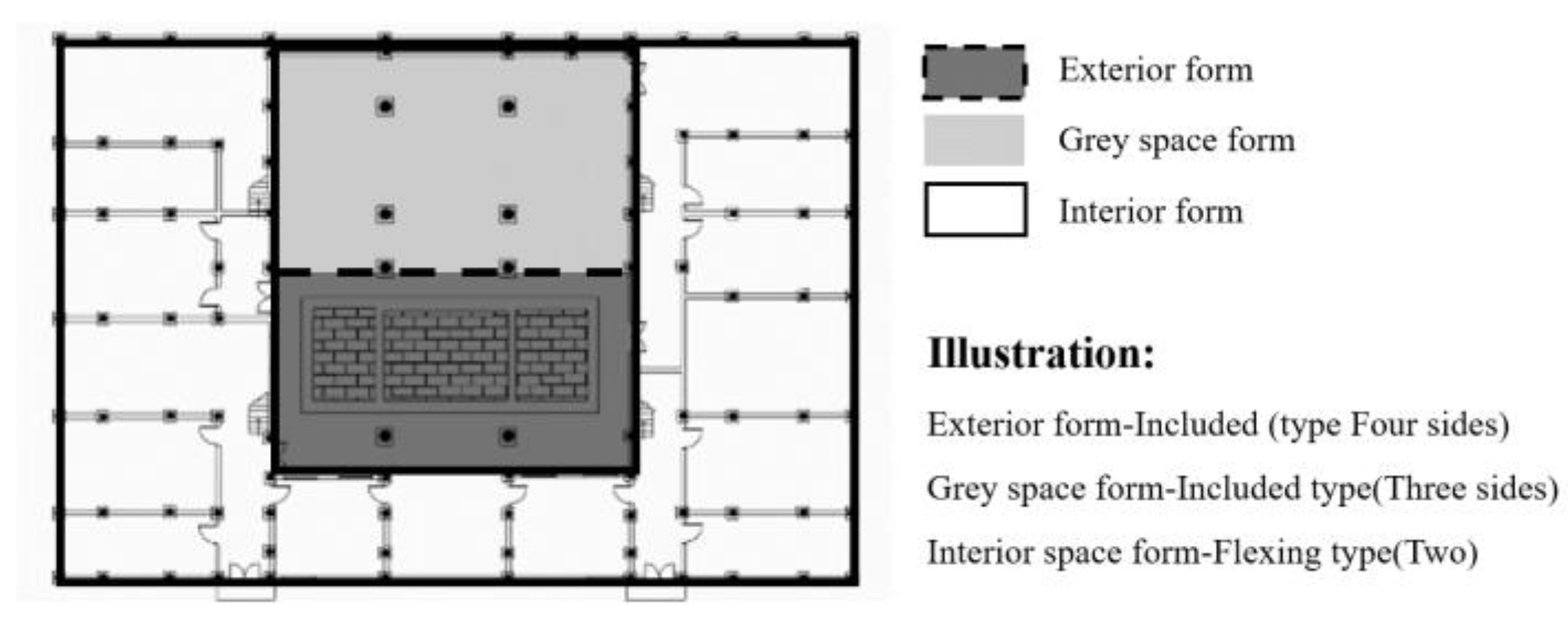
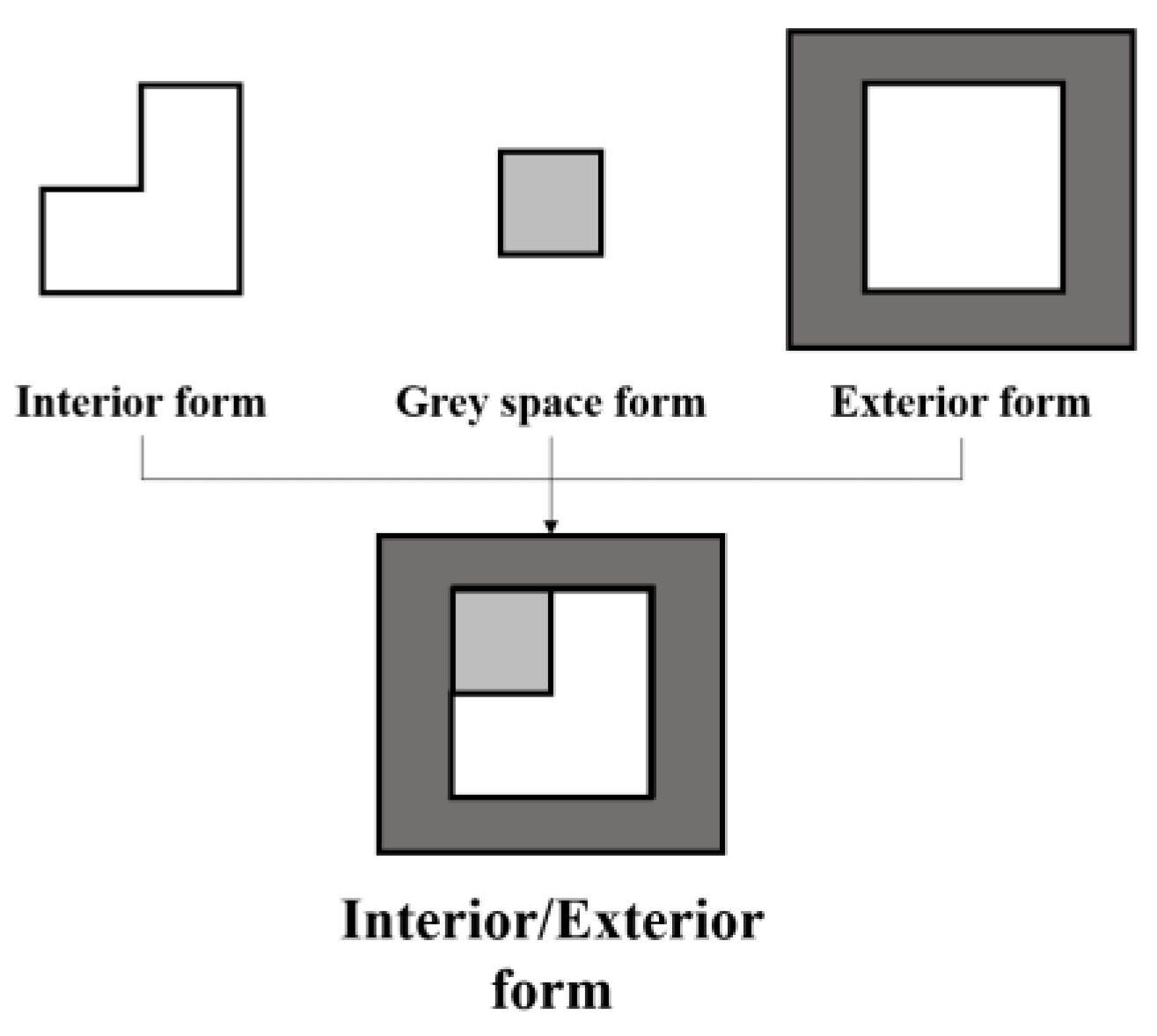
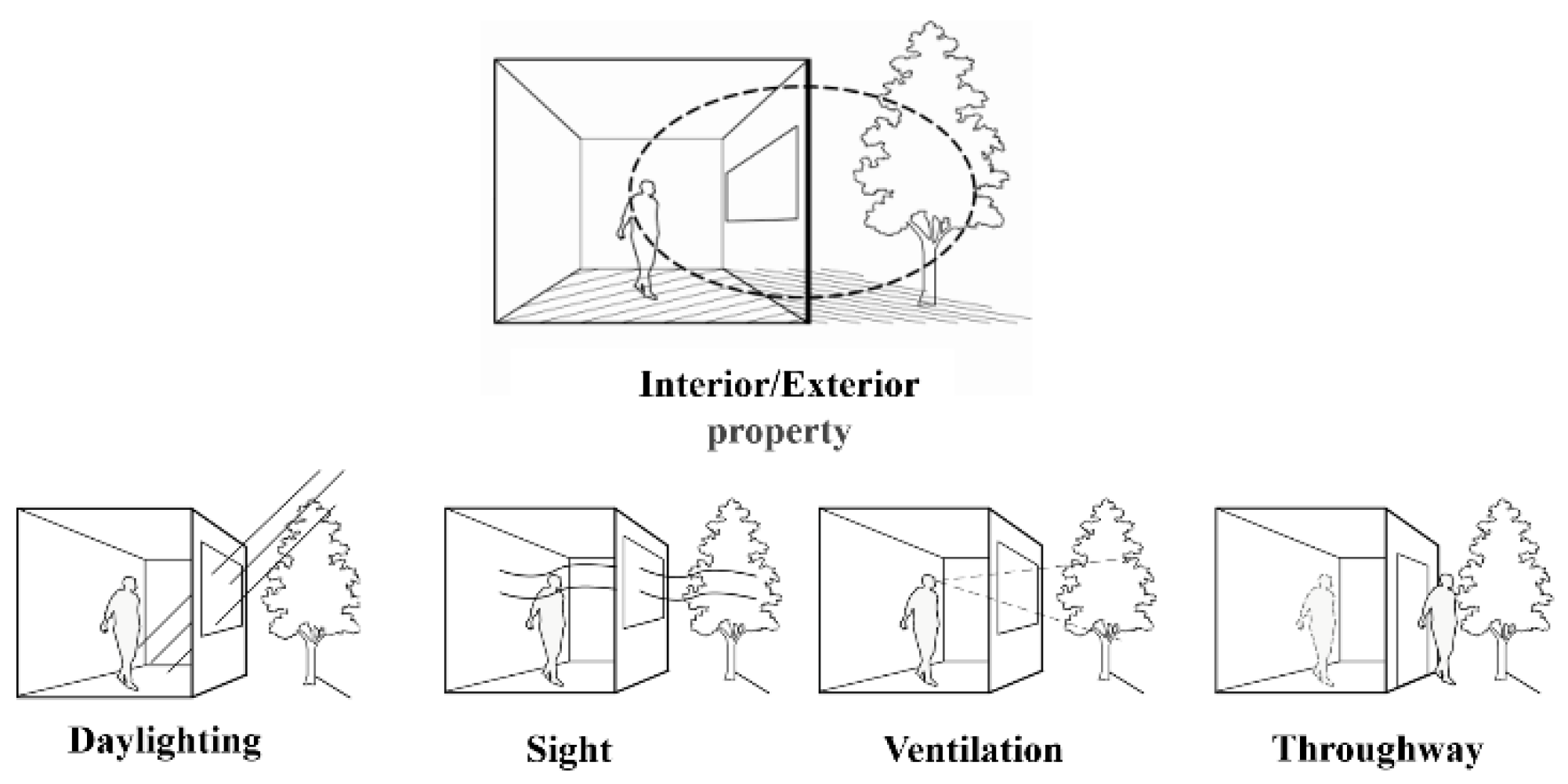


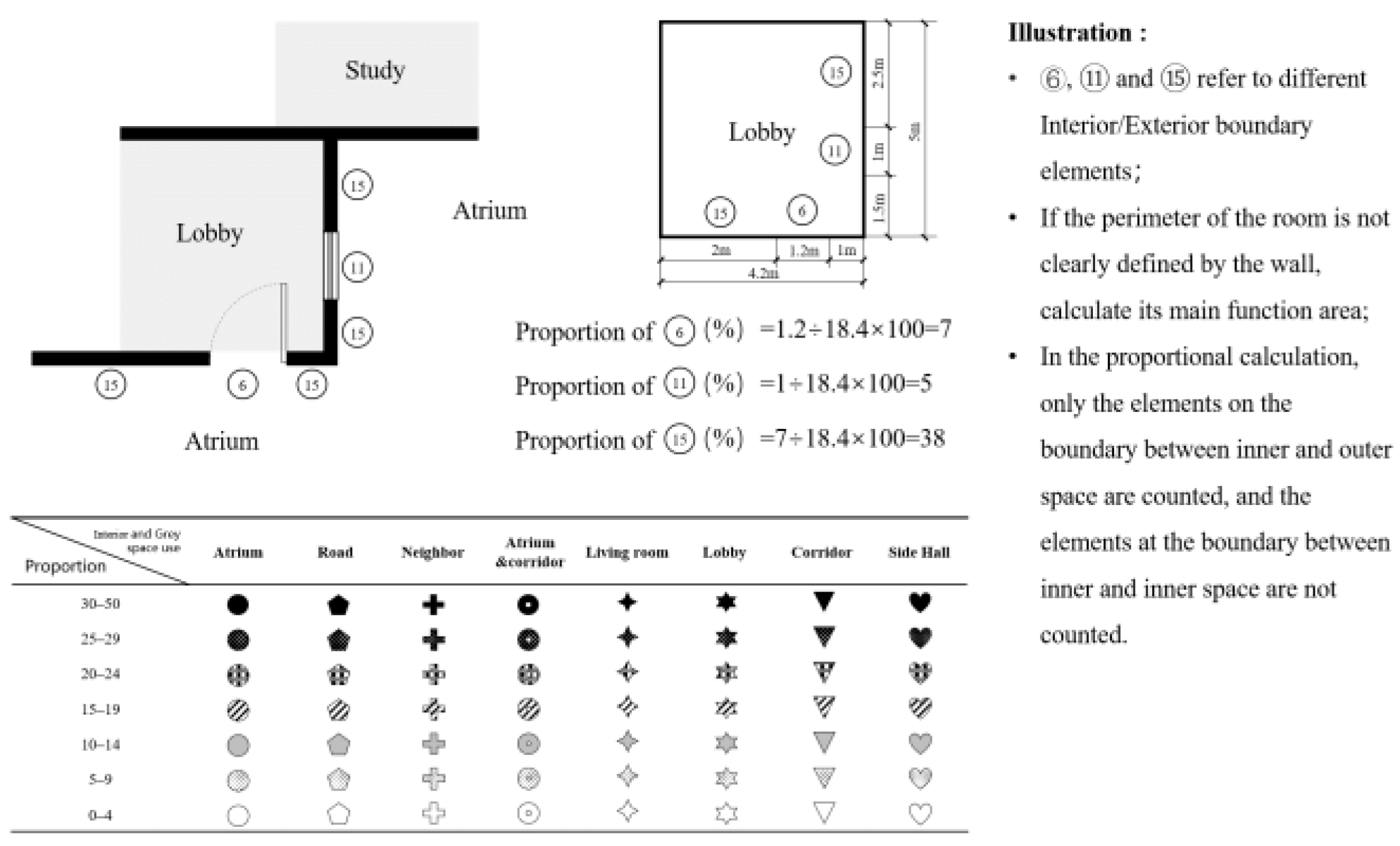

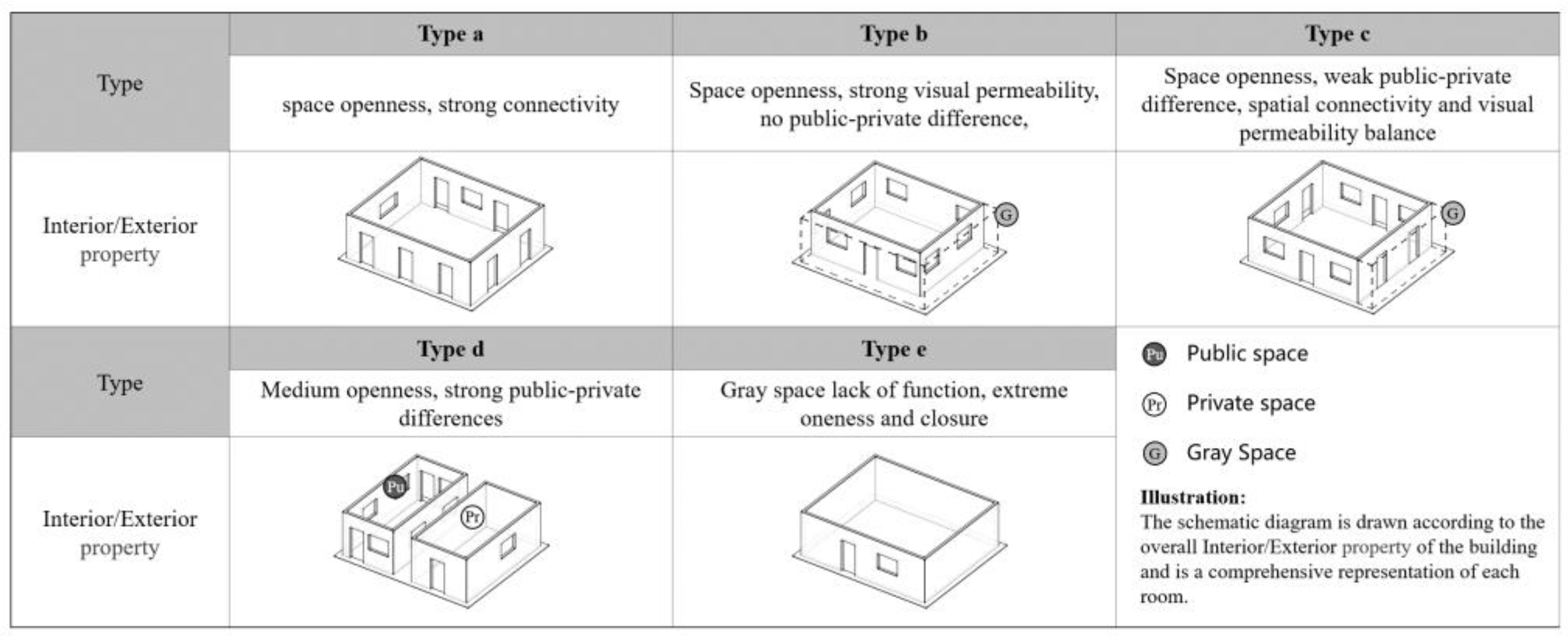


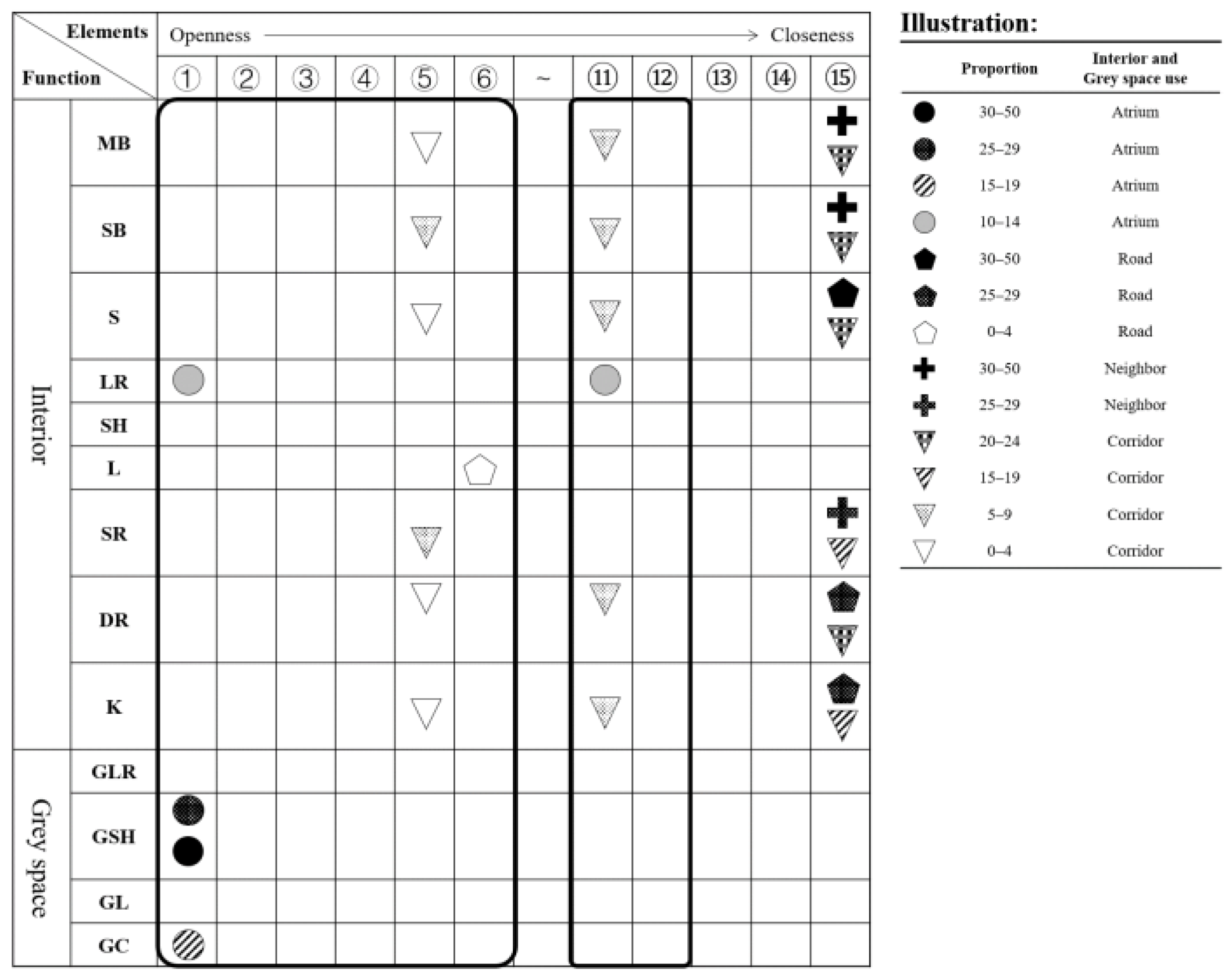
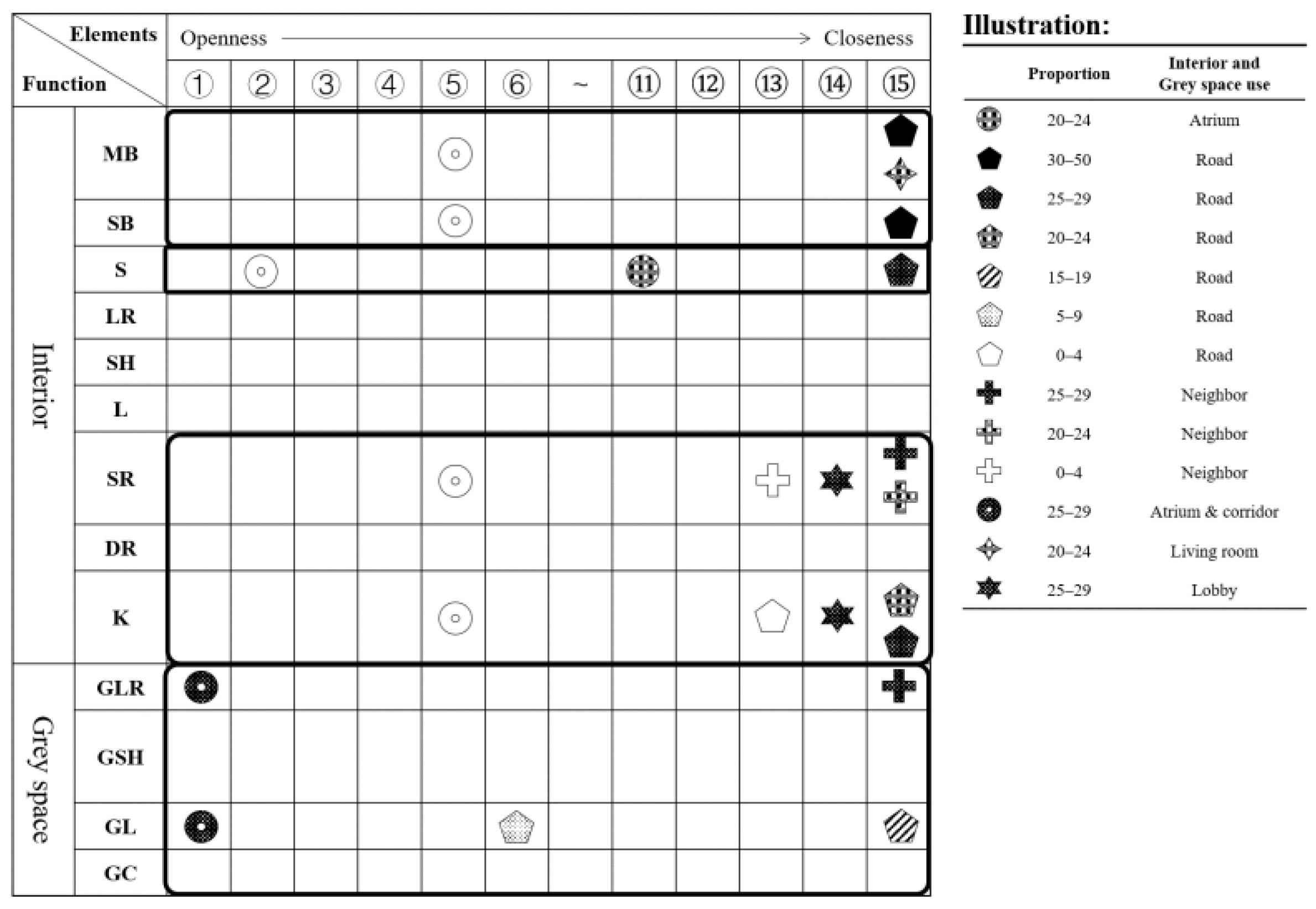
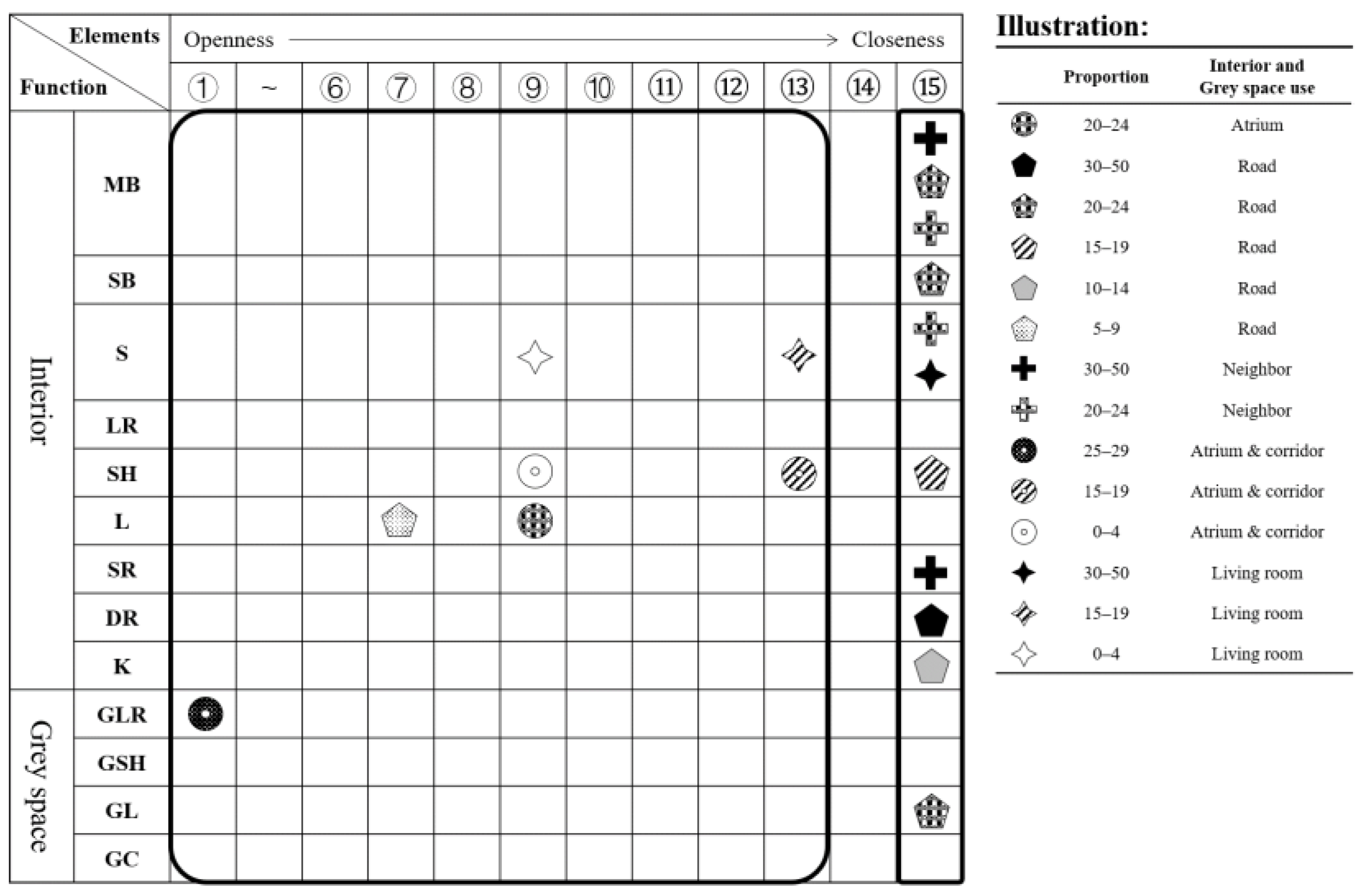
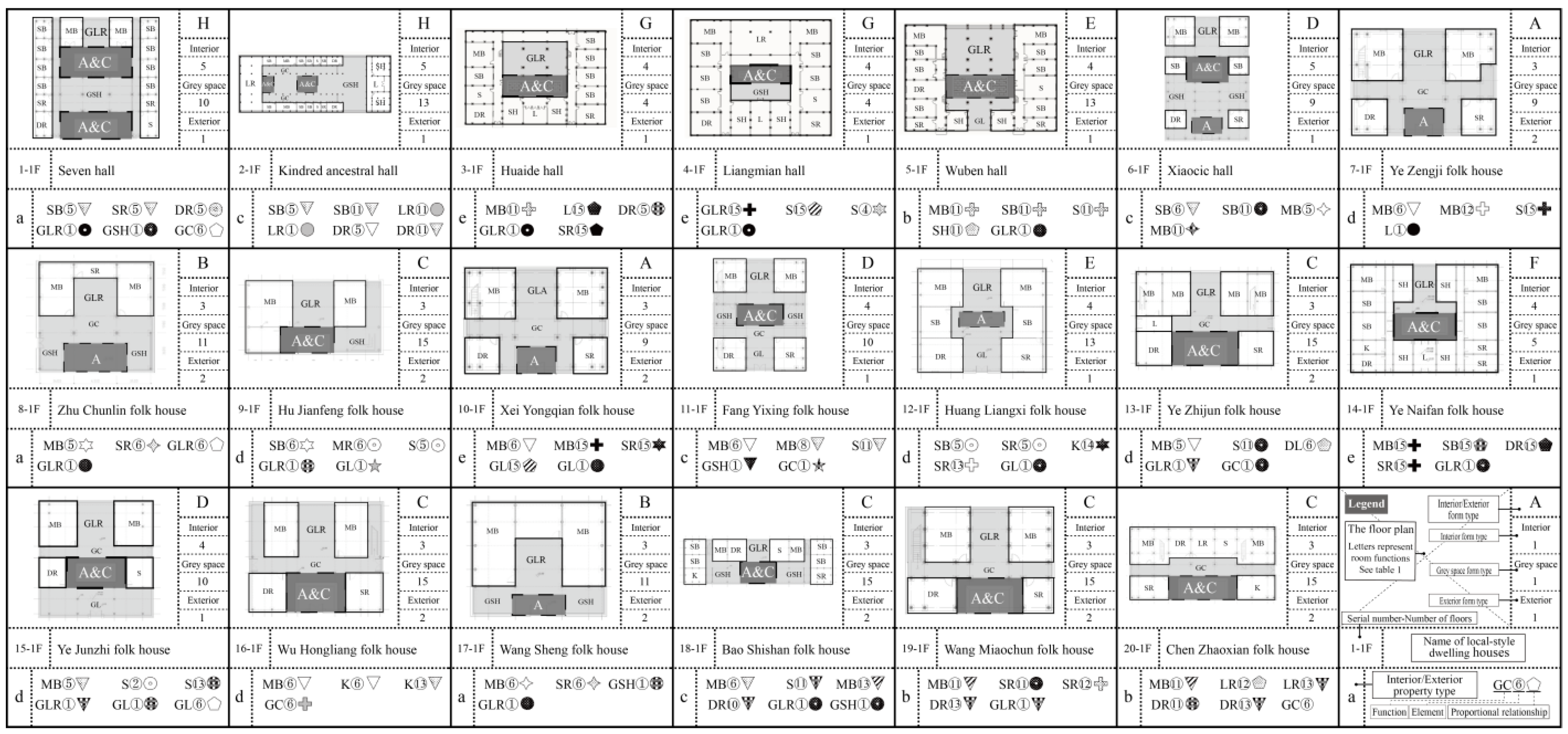

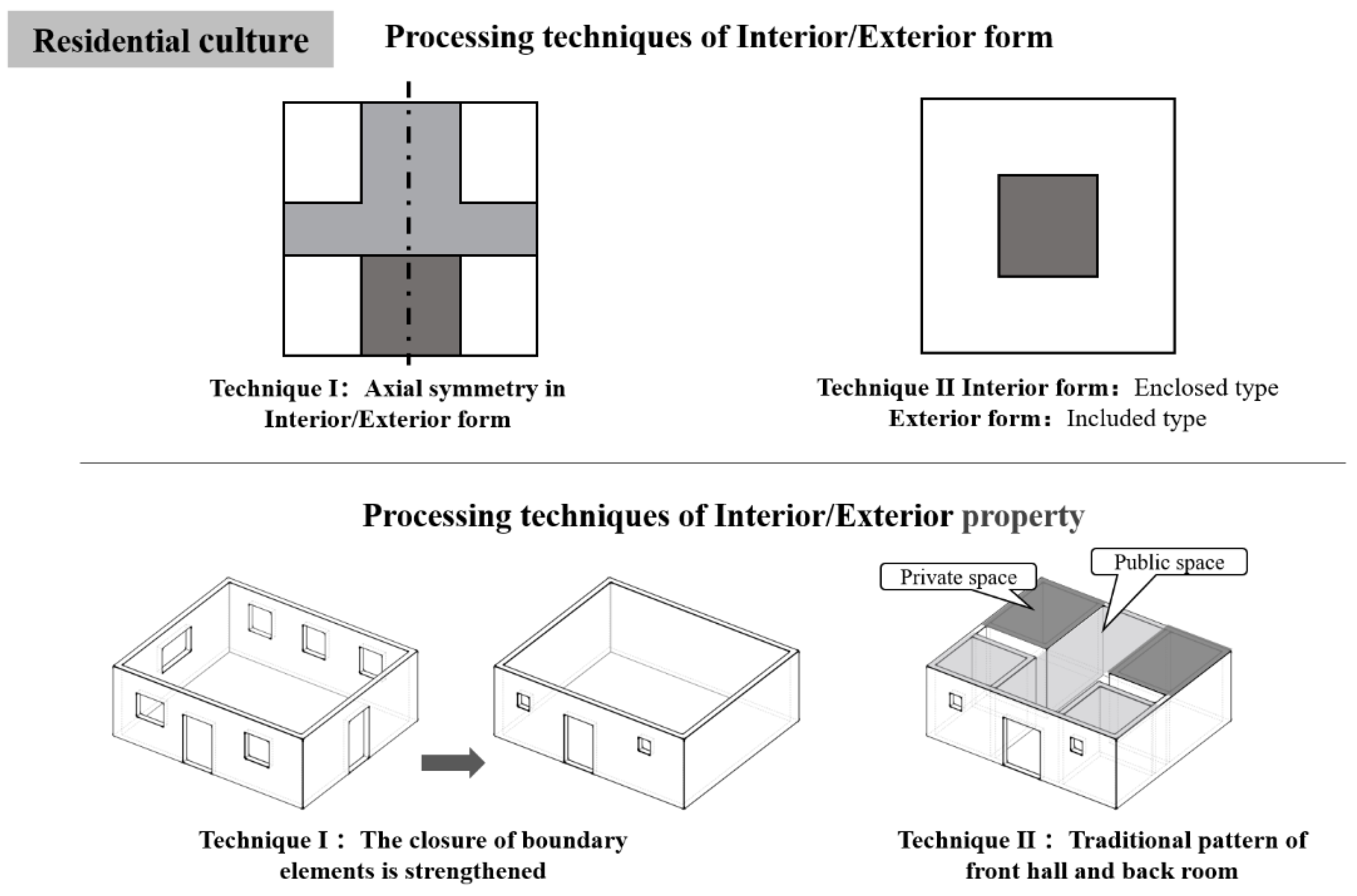
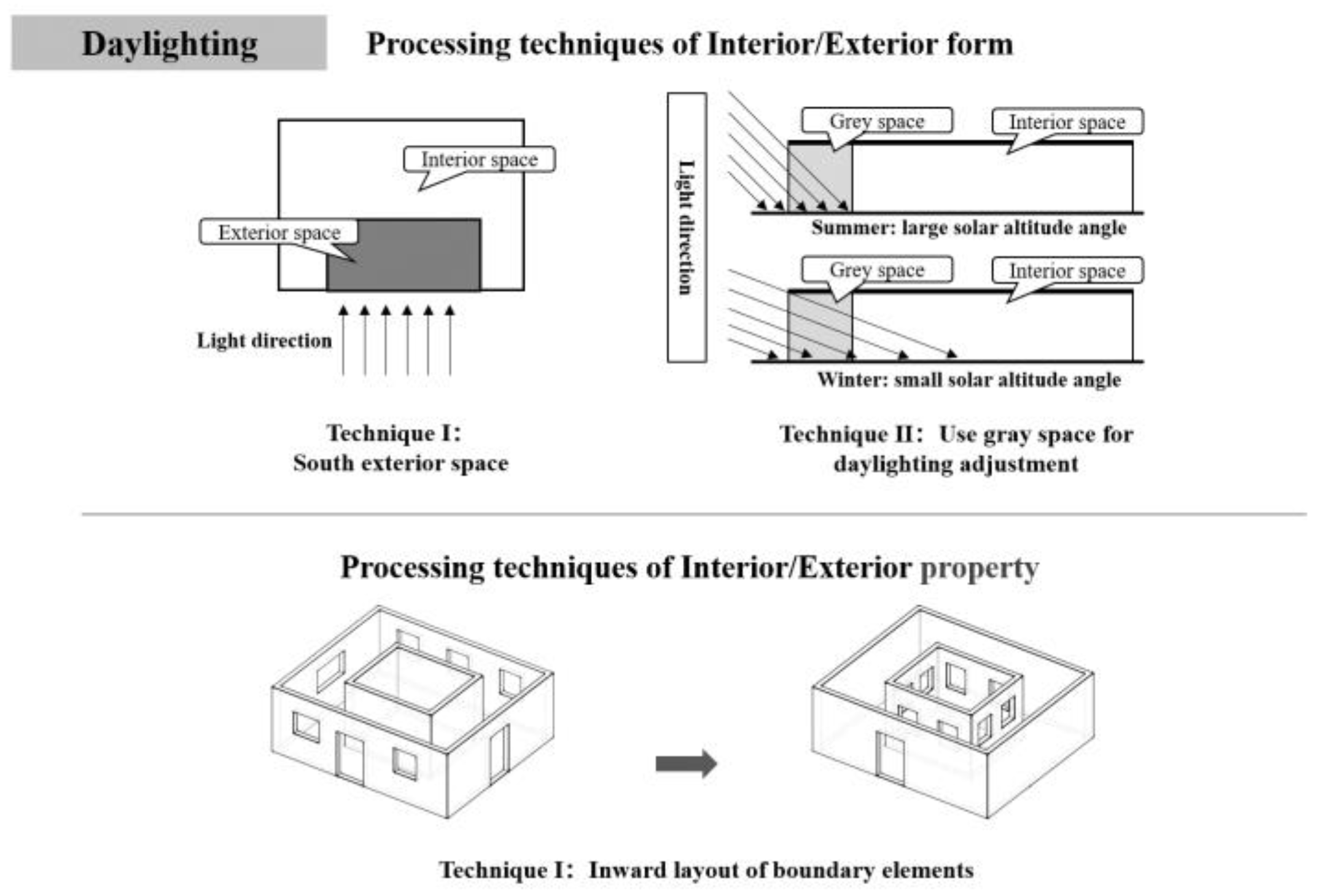
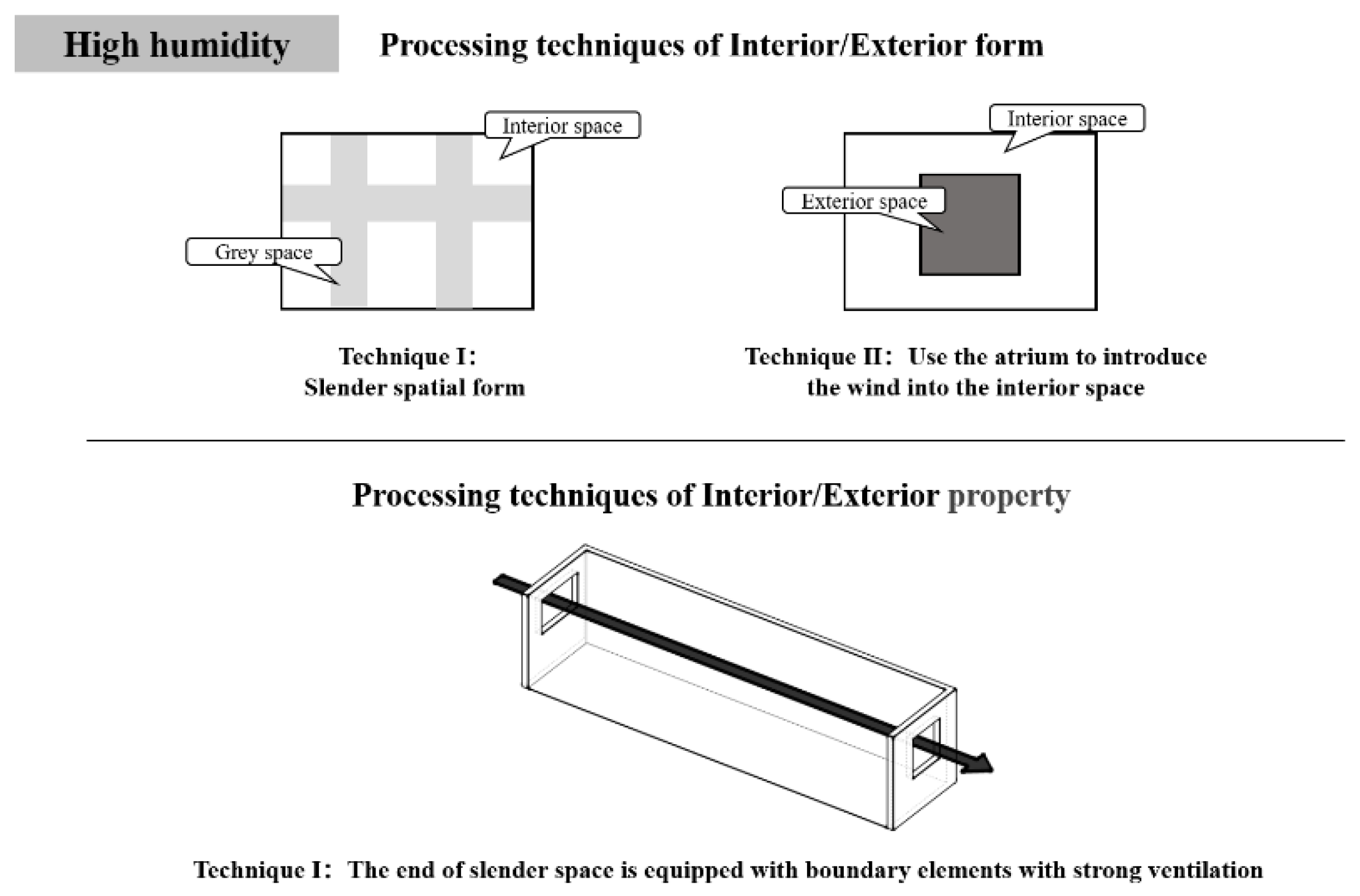
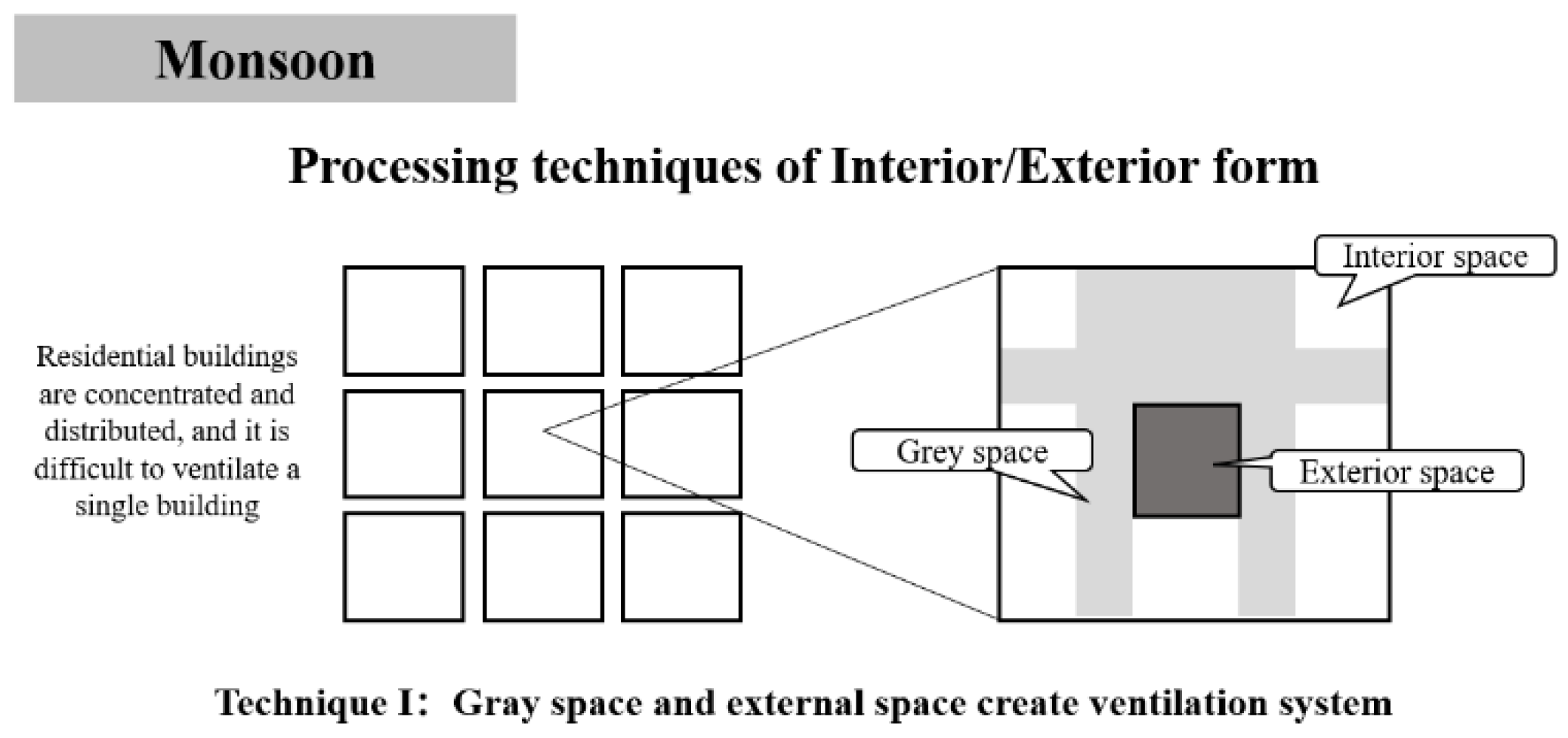
| Interior Function | Gray Space Function | Exterior Function | ||||
|---|---|---|---|---|---|---|
| Master bedroom (MB) | Secondary bedroom (SB) | Study (S) | Living room (GLR) | Corridor (GC) | Atrium (A) | Atrium and corridor (A&C) |
| Living room (LR) | Side hall (SH) | Lobby (L) | Lobby (GL) | Side hall (GSH) | Neighbor (N) | Road (R) |
| Storeroom (SR) | Dining room (DR) | Kitchen (K) | ||||
Publisher’s Note: MDPI stays neutral with regard to jurisdictional claims in published maps and institutional affiliations. |
© 2022 by the authors. Licensee MDPI, Basel, Switzerland. This article is an open access article distributed under the terms and conditions of the Creative Commons Attribution (CC BY) license (https://creativecommons.org/licenses/by/4.0/).
Share and Cite
Yan, D.; Xu, M.; Chai, B.; Chen, Z.; Bai, C. Interior/Exterior Form and Property Research on Wu-Style Residential Houses from the Perspective of Sustainable Development. Sustainability 2022, 14, 5140. https://doi.org/10.3390/su14095140
Yan D, Xu M, Chai B, Chen Z, Bai C. Interior/Exterior Form and Property Research on Wu-Style Residential Houses from the Perspective of Sustainable Development. Sustainability. 2022; 14(9):5140. https://doi.org/10.3390/su14095140
Chicago/Turabian StyleYan, Dan, Minghui Xu, Binbin Chai, Zhiwen Chen, and Congxia Bai. 2022. "Interior/Exterior Form and Property Research on Wu-Style Residential Houses from the Perspective of Sustainable Development" Sustainability 14, no. 9: 5140. https://doi.org/10.3390/su14095140
APA StyleYan, D., Xu, M., Chai, B., Chen, Z., & Bai, C. (2022). Interior/Exterior Form and Property Research on Wu-Style Residential Houses from the Perspective of Sustainable Development. Sustainability, 14(9), 5140. https://doi.org/10.3390/su14095140






